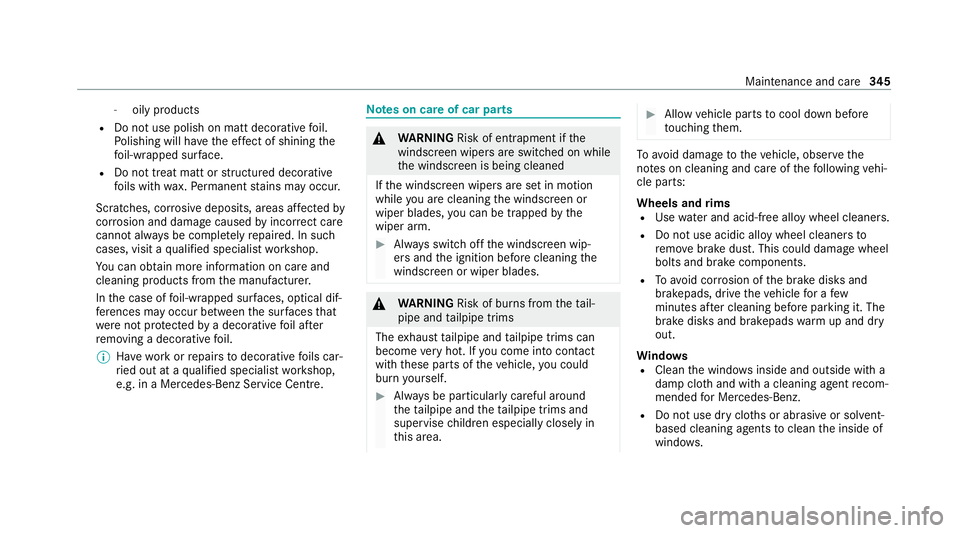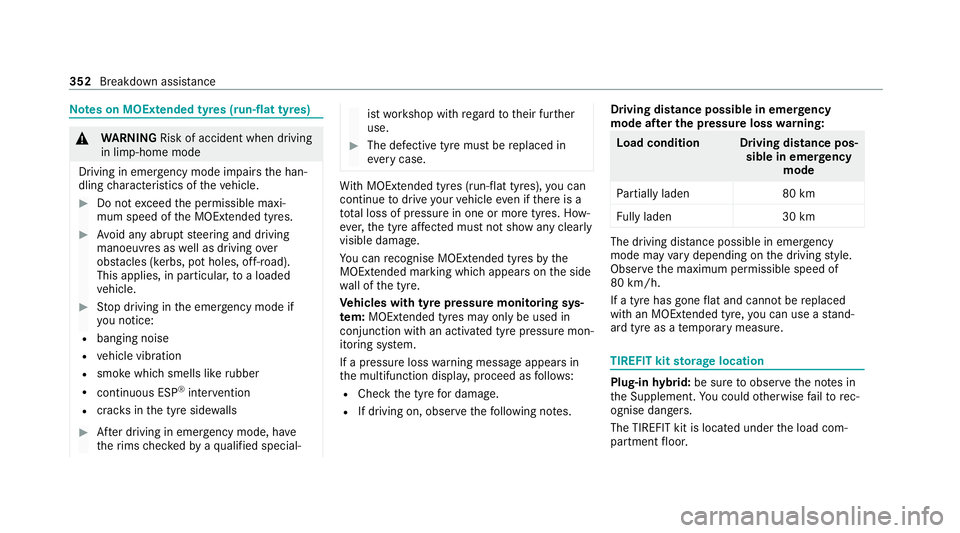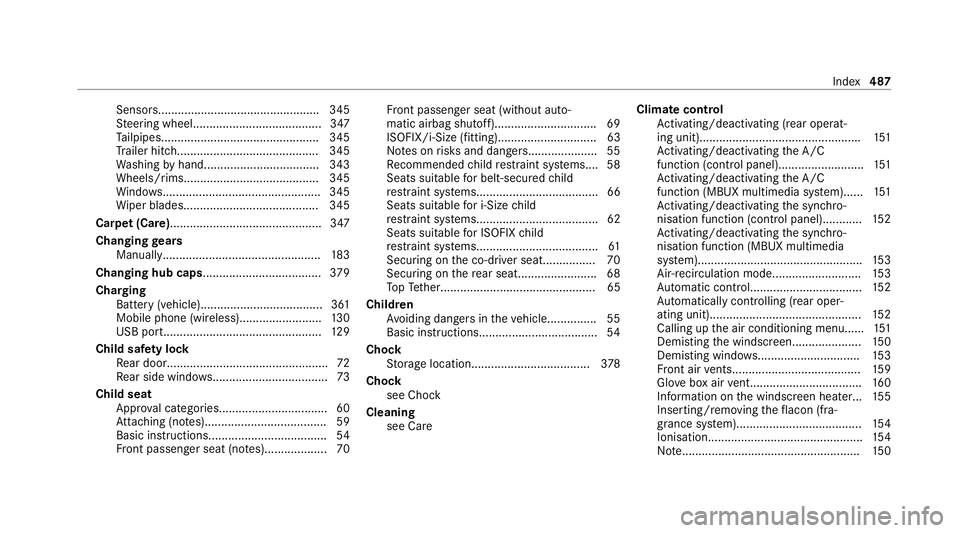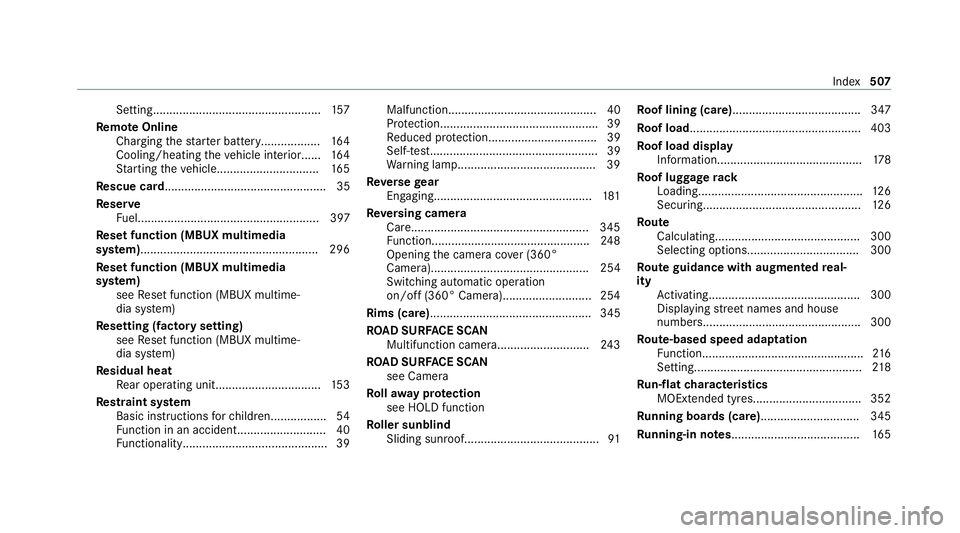2021 MERCEDES-BENZ GLE COUPE rims
[x] Cancel search: rimsPage 119 of 525

In addition,
flammable materials may ignite
if:
R you drop the hot cigar ette lighter
R ach ild holds the hot cigar ette lighter to
objects, forex ample #
Alw ays hold the cigar ette lighter bythe
knob. #
Alw ays make sure that the cigar ette
lighter is out of reach of children. #
Never lea vechildren unat tended in the
ve hicle. &
WARNING Risk of burn s fromtheta il‐
pipe and tailpipe trims
The exhaust tailpipe and tailpipe trims can
become very hot. If you come into contact
with these parts of theve hicle, you could
burn yourself. #
Alw ays be particular lycareful around
th eta ilpipe and theta ilpipe trims and
supervise children especially closely in
th is area. #
Allow vehicle parts tocool down before
to uching them. The driving
characteristics of your vehicle are
dependent on the distribution of the load within
th eve hicle. You should bear thefo llowing in
mind when loading theve hicle:
R neverex ceed the permissible gross mass or
th e permissible axle loads forth eve hicle
(including occupants).
Information can be found on theve hicle iden‐
tification plate (/ page 391).
R the load must not pr otru de abo vethe upper
edge of the seat backrests.
R always use the partition net when transport‐
ing objects in the load compartment.
R always place the load behind unoccupied
seats if possible.
R secure the load using the tie-down eyes and
distribute the load evenly.
No tes on driving with a roof load
R Evenly distribute thero of load, and place
heavy objects at the bottom. Also comply with
the no tes on loading theve hicle
(/ page 114).
R Drive attentivel y,and avoid suddenly pulling
aw ay, braking and steering as well as rapid
cornering.
R When transporting roof loads and when the
ve hicle is fully loaded or fully occupied,
select drive programs ;andA. These
are designed tofocus on stability
(/ page 177). 11 6
Seats and stowing
Page 348 of 525

-
oily products
R Do not use polish on matt decorative foil.
Po lishing will ha vethe ef fect of shining the
fo il-wrapped sur face.
R Do not treat matt or stru ctured deco rative
fo ils with wax.Pe rm anent stains may occur.
Sc ratches, cor rosive deposits, areas af fected by
cor rosion and damage caused byincor rect care
cannot al ways be comple tely re paired. In such
cases, visit a qualified specialist workshop.
Yo u can obtain more information on care and
cleaning products from the manufacturer.
In the case of foil-wrapped sur faces, optical dif‐
fe re nces may occur between the sur faces that
we renot pr otected bya decorative foil af ter
re moving a decorative foil.
% Have wo rkor repairs todecorative foils car‐
ri ed out at a qualified specialist workshop,
e.g. in a Mercedes-Benz Service Centre. Note
s on care of car parts &
WARNING Risk of entrapment if the
windscreen wipers are swit ched on while
th e windscreen is being cleaned
If th e windscreen wipers are set in motion
while you are cleaning the windscreen or
wiper blades, you can be trapped bythe
wiper arm. #
Alw ays switch off the windscreen wip‐
ers and the ignition before cleaning the
windscreen or wiper blades. &
WARNING Risk of burn s fromtheta il‐
pipe and tailpipe trims
The exhaust tailpipe and tailpipe trims can
become very hot. If you come into contact
with these parts of theve hicle, you could
burn yourself. #
Alw ays be particular lycareful around
th eta ilpipe and theta ilpipe trims and
supervise children especially closely in
th is area. #
Allow vehicle parts tocool down before
to uching them. To
avo id damage totheve hicle, obser vethe
no tes on cleaning and care of thefo llowing vehi‐
cle parts:
Wheels and rims
R Use wate r and acid-free alloy wheel cleaners.
R Do not use acidic alloy wheel cleaners to
re mo vebrake dust. This could damage wheel
bolts and brake components.
R Toavo id cor rosion of the brake disks and
brakepads, drive theve hicle for a few
minutes af ter cleaning before parking it. The
brake disks and brakepads warm up and dry
out.
Wi ndo ws
R Clean the windo wsinside and outside with a
damp clo thand with a cleaning agent recom‐
mended for Mercedes-Benz.
R Do not use dry clo ths or abrasive or sol vent-
based cleaning agents toclean the inside of
windo ws. Maintenance and care
345
Page 355 of 525

Note
s on MOExtended tyres (run-flat tyres) &
WARNING Risk of accident when driving
in limp -home mode
Driving in emergency mode impairs the han‐
dling characteristics of theve hicle. #
Do not exceed the permissible maxi‐
mum speed of the MOEx tended tyres. #
Avoid any abrupt steering and driving
manoeuvres as well as driving over
obs tacles (kerbs, pot holes, off-road).
This applies, in pa rticular, toa loaded
ve hicle. #
Stop driving in the emer gency mode if
yo u notice:
R banging noise
R vehicle vibration
R smoke which smells like rubber
R continuous ESP ®
inter vention
R crac ksinthe tyre side walls #
After driving in emergency mode, ha ve
th erims checkedby aqu alified special‐ ist
workshop with rega rd totheir fur ther
use. #
The defective tyre must be replaced in
eve rycase. Wi
th MOExtended tyres (run-flat tyres), you can
continue todrive your vehicle even if there is a
tot al loss of pressure in one or more tyres. How‐
eve r,th e tyre af fected must not show any clearly
visible damage.
Yo u can recognise MOExtended tyres bythe
MOExtended marking which appears on the side
wa ll of the tyre.
Ve hicles with tyre pressure monitoring sys‐
te m: MOExtended tyres may only be used in
conjunction wi than activated tyre pressure mon‐
itoring sy stem.
If a pressure loss warning message appears in
th e multifunction displa y,proceed as follo ws:
R Check the tyre for dama ge.
R If driving on, obser vethefo llowing no tes. Driving distance possible in emer
gency
mode af ter the pressure loss warning: Load condition Driving distance pos‐
sible in emergency
mode
Pa rtially laden 80 km
Fu lly laden 30 km The driving dis
tance possible in emergency
mode may vary depending on the driving style.
Obser vethe maximum permissible speed of
80 km/h.
If a tyre has gone flat and cannot be replaced
with an MOEx tended tyre, you can use a stand‐
ard tyre as a temp orary measure. TIREFIT kit
storage location Plug-in
hybrid: be sure toobser vethe no tes in
th e Supplement. You could otherwise failto rec‐
ognise dangers.
The TIREFIT kit is loca ted under the load com‐
partment floor. 352
Breakdown assis tance
Page 356 of 525

1
Tyre sealant bottle
2 Tyre inflation compressor
Depending on the model, the TIREFIT kit may
also be located in other places under the load
compartment floor.
% You can find information on the po wer cate‐
gory (LK) and/or electrical data on the back
of the tyre inflation compressor:
R LK3 – 12V/20A, 240W, 1kg At
a dis tance of appr oximately 1 m tothe
tyre inflation compressor and appr oximately
1. 6 m abo vethe ground, thefo llowing sound
pressure le vels apply:
R Emission sound pressure le vel L
PA 84
dB
(A)
R Sound po wer le vel L
WA 92 dB (A)
The tyre inflation compressor is mainte‐
nance-free. If there is a malfunction, please
conta ct aqualified specialist workshop. Using
the TIREFIT kit Re
quirements:
R Tyre sealant bottle and tyre inflation com‐
pressor (/ page 352).
R TIREFIT sticker
R Gloves (depending on theve hicle equipment)
Yo u can use TIREFIT tyre sealant toseal per fora‐
tion dama geof up to4 mm, particularly those in
th e tyre conta ct surface.You can use TIREFIT in
outside temp eratures down to-20°C. &
WARNING Risk of accident when using
tyre sealant
The tyre sealant may be unable toseal the
tyre proper ly, especially in thefo llowing
cases:
R there are large cuts or punctures in the
tyre (larger than damage pr eviously men‐
tioned)
R the wheel rims ha vebeen damaged
R afte r journe yswith very low tyre pressure
or with flat tyres #
Do not continue driving. #
Consult a qualified specialist workshop. &
WARNING Risk of injury and poisoning
from tyre sealant
Ty re sealant is hazardous tohealth and cau‐
ses ir rita tion. Do not allow it tocome into
contact wi thyour skin, eyes or clo thing, and
do not swallow it. Do not inhale any vapours.
Ke ep the tyre sealant away from children. Breakdown assis
tance 353
Page 490 of 525

Senso
rs................................................. 345
St eering wheel....................................... 347
Ta ilpipes................................................ 345
Tr ailer hit ch........................................... 345
Wa shing byhand................................... 343
Wheels/rims.........................................3 45
Wi ndo ws................................................ 345
Wi per blades.........................................3 45
Carpet (Care).............................................. 347
Changing gears
Manually. ............................................... 183
Changing hub caps .................................... 379
Cha rging
Bat tery (vehicle).....................................3 61
Mobile phone (wireless).........................1 30
USB port................................................ 12 9
Child saf ety lock
Re ar door................................................ .72
Re ar side wind ows................................... 73
Child seat App rova l categories................................ .60
At tach ing (no tes).....................................59
Basic instructions.................................... 54
Fr ont passenger seat (no tes)...................70 Fr
ont passenger seat (without auto‐
matic airbag shutoff)...............................69
ISOFIX/i-Size (fitting).............................. 63
No tes on risks and dangers..................... 55
Re commended child restra int sy stems.... 58
Seats suitable for belt-secu redch ild
re stra int sy stems..................................... 66
Seats suitable for i‑Size child
re stra int sy stems..................................... 62
Seats suitable for ISOFIX child
re stra int sy stems..................................... 61
Secu ring on the co-driver seat................70
Secu ring on there ar seat........................ 68
To pTe ther............................................... 65
Children Avoiding dangers in theve hicle............... 55
Basic instructions.................................... 54
Chock Storage location.................................... 378
Chock see Chock
Cleaning see Care Climate control
Activating/deactivating (rear operat‐
ing unit)................................................ .151
Ac tivating/deactivating the A/C
function (contro l panel).......................... 151
Ac tivating/deactivating the A/C
function (MBUX multimedia sy stem)...... 151
Ac tivating/deactivating the synchro‐
nisation function (contro l panel)............15 2
Ac tivating/deactivating the synchro‐
nisation function (MBUX multimedia
sy stem).................................................. 15 3
Air-reci rculation mode...........................1 53
Au tomatic control.................................. 15 2
Au tomatically controlling (rear oper‐
ating unit).............................................. 15 2
Calling up the air conditioning menu...... 151
Demi sting the windscreen..................... 15 0
Demi sting windo ws............................... 15 3
Fr ont air vents....................................... 15 9
Glo vebox air vent.................................. 16 0
Information on the windscreen heater... 15 5
Inserting/removing theflacon (fra‐
gr ance sy stem)...................................... 154
Ionisation............................................... 154
No te...................................................... 15 0 Index
487
Page 510 of 525

Setting...................................................
157
Re mo teOnline
Charging thest ar ter battery.................. 16 4
Cooling/heating theve hicle interior...... 16 4
St arting theve hicle...............................1 65
Re scue card................................................. 35
Re ser ve
Fu el....................................................... 397
Re set function (MBUX multimedia
sy stem)..................................................... .296
Re set function (MBUX multimedia
sy stem)
see Reset function (MBUX multime‐
dia sy stem)
Re setting (factory setting)
see Reset function (MBUX multime‐
dia sy stem)
Re sidual heat
Re ar operating unit................................ 15 3
Re stra int sy stem
Basic instructions forch ildren................ .54
Fu nction in an accident........................... 40
Fu nctionality............................................ 39 Malfunction............................................. 40
Pr
otection................................................ 39
Re duced pr otection.................................39
Self-test................................................... 39
Wa rning lamp......................................... .39
Re versege ar
Engaging................................................ 181
Re versing camera
Care..................................................... .345
Fu nction................................................ 24 8
Opening the camera co ver (360°
Camera)................................................ 254
Switching auto matic operation
on/off (360° Camera)........................... 254
Rims (care)................................................. 345
RO AD SUR FACE SCAN
Multifunction camera............................ 24 3
RO AD SUR FACE SCAN
see Camera
Ro llaw ay protection
see HOLD function
Ro ller sunblind
Sliding sunroof......................................... 91Ro
of lining (care) ...................................... .347
Ro of load .................................................... 403
Ro of load display
In fo rm ation............................................ 178
Ro of luggage rack
Loading.................................................. 12 6
Secu ring................................................ 12 6
Ro ute
Calculating............................................ 300
Selecting options.................................. 300
Ro ute guidance with augmented real‐
ity
Activating.............................................. 300
Displ aying stre et names and house
numbe rs................................................ 300
Ro ute-based speed adaptation
Fu nction................................................. 216
Setting................................................... 218
Ru n-flat characteristics
MOExtended tyres................................. 352
Ru nning boards (care).............................. 345
Ru nning-in no tes....................................... 16 5 Index
507